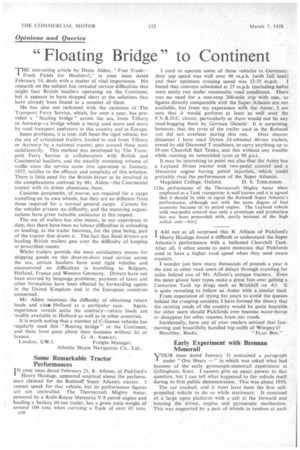"Floating Bridge" to Continent
Page 72

If you've noticed an error in this article please click here to report it so we can fix it.
THE interesting article by Denis Alden, "Free Trade- I Fresh Fields for Hauliers?," in your issue dated February 14, deals with a matter of vital importance. His research on the subject has revealed certain difficulties that might face British hauliers operating on the Continent, but it appears to have stopped short at the solutions that have already been found to a number of them.
He has also not reckoned with the existence of The Transport Ferry Service, which, for over a year, has provided a "floating bridge" across the sea, from Tilbury to Antwerp—a bridge which is being used more and more by road transport opaators in this country and in Europe.
Some problems, it is true, still beset the rigid vehicle, but the use of articulated trailers, hauled to and from Tilbury or Antwerp by a national tractor, gets around these most satisfactorily. This method was developed by The Transport Ferry Service in collaboration with British and Continental hauliers, and the steadily mounting volume of traffic since the service came into operation in January, 1957, testifies to the efficacy and simplicity of this solution. There is little need for the British driver to be involved in the complications outlined by Mr. Alden—the Continental tractor with its driver eliminates them.
Customs documents, of course, are required for a cargo travelling on its own wheels; but they are no different from those required for a normal general cargo. Carnets for the vehicles present no difficulty, and the motoring organizations have given valuable assistance in this respect.
, The use of trailers has also meant, in our experience to date, that there have been no labour difficulties in unloading or loading, as the trailer becomes, for the time being, part of the tractor that draws it. The fact that local drivers are hauling British trailers gets over the difficulty of keeping to prescribed routes: Whilst trailers provide the most satisfactory means for shipping goods on this door-to-door road service across the sea, certain hauliers have used rigid vehicles and encountered no difficulties in travelling to Belgium, Holland, France and Western Germany. Drivers have not been worried by language problems; payment of taxes and other formalities have been effected by forwarding agents in the United Kingdom and in the European countries concerned.
. Mr. Alden mentions the. difficulty of. obtaining return loads and citer Holland as a particular case. Again, experience reveals quite the contrary—return loads are readily available in Holland as well as in other countries.
. It is worth noting that a number of C-licence vehicles has regularly used this "floating bridge" to the Continent, and these have gone about their business without let or licence. G. A. ASHLEY, London, S.W.1. Freight Manager, Atlantic Stearn Navigation Co., Ltd., I used to operate some of these vehicles in Germany: their top speed was well over 40 m.p.h. (with full load)
and their optimum cruising speed was 32-35 m.p.h. I found that convoys scheduled at 25 m.p.h. (including halts) were easily run -under reasonable road conditions. There was no need for a non-stop 200-mite trip with one, so figures directly comparable with the Super Atlantic are not available, but from my experience with the Antar, I am sure that it wonld perform at least as well over the F.V.R.D.E. circuit,particularly as there would not be any road-hogging there by German Diesels! It is surprising, however, that the tyres of the trailer used in the Rotinoff
test did not overheat during this run. Over shorter distances I have used Dyson 24-wheeled 40-ton trailers, towed by old Diamond T machines, to carry anything up to 59-ton Churchill flail Tanks, and this without any trouble while running on remoulded tyres at 90 p.s.i.
It may be interesting to point out also that the Army has a Leyland 30-ton tractor with two-pedal control and a Meteorite engine having petrol injection, which could probably rival the performance of the Super Atlantic.
Magdalen College, Oxford. D. S. Tomur4soN.
[The performance of the Thornycroft Mighty Antar when employed as a Tank transporter is well known and it is agreed that it should be able to equal the Rotinoff Super Atlantic's performance, although not with the same degree of fuel economy because of its petrol engine. The Leyland vehicle with two-pedal control was only a prototype and production has not been proceeded with, partly because of the high initial cost.--ED.1 I AM not at all surprised that R. Allison of Pickford's I Heavy Haulage found it difficult to understand the Super Atlantic's performance with a ballasted Churchill Tank. After all, it often seems to mere motorists that Pickfords used to have a higher road speed when they used steam tractors.
I wonder just how many thousands of pounds a year is the cost to other road users of delays through crawling for miles behind one of Mr. Allison's antique tractors. Even his more glossy later types make a great fuss over getting a Centurion Tank up drags such as Brickhill on A5. It is quite revealing to follow an Antar with a similar load.
From experience of trying for years to avoid the queues behind the creeping ancients, I have formed the theory that the existing roads of the country, would be quite bearable for other users should Pickfords ever become water-borne or disappear for other reasons from our roads.
Incidentally, have any of your readers noticed that fastmoving and beautifully handled big outfit of Wimpey's?
Bletchley, Bucks. " FLA0 BOY."
























































































































